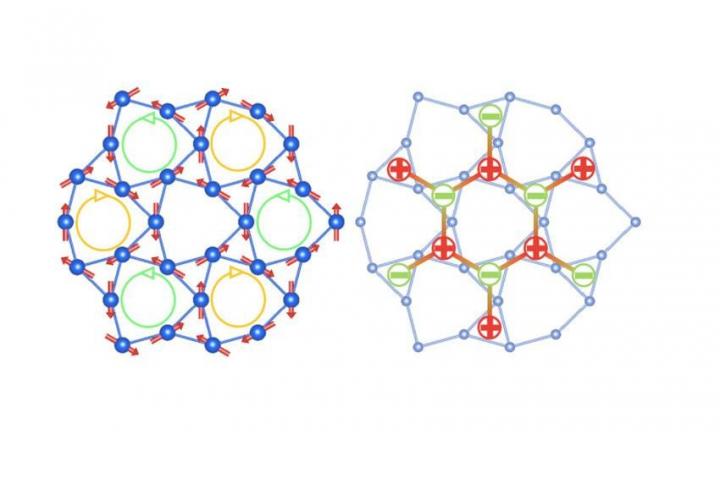
Credit: Uni Augsburg
Magnetic monopoles were detected for the first time worldwide at the Berlin Neutron Source BER II in 2008. At that time they in a one-dimensional spin system of a dysprosium compound. About 10 years ago, monopole quasi-particles could also be detected in two-dimensional spin-ice systems consisting of tetrahedral crystal units. However, these spin-ice materials were electrical insulators.
Now: Magnetic monopoles in a metal
Dr. Kan Zhao and Prof. Philipp Gegenwart from the University of Augsburg, together with teams from the Heinz Meier Leibnitz Centre, Forschungszentrum Jülich, the University of Colorado, the Academy of Sciences in Prague and the Helmholtz-Zentrum Berlin, have now shown for the first time that a metallic compound can also form such magnetic monopoles. The team in Augsburg prepared crystalline samples from the elements holmium, silver and germanium for this purpose.
Kagome spin-ice system means frustration
In the HoAgGe crystals, the magnetic moments (spins) of the holmium atoms form a so-called two-dimensional Kagome pattern. This name comes from the Japanese Kagome braiding art, in which the braiding bands are not woven at right angles to each other, but in such a way that triangular patterns are formed.
In the Kagome-pattern the spins of neighbouring atoms can not be aligned contrary to each other as usual. Instead, there are two permitted spin configurations: Either the spins of two of the three atoms point exactly towards the center of the triangle, while those of the third atom point out of the center. Or it is exactly the other way round: One spin points to the center, the other two out of it. This limits the possibilities of spin arrangements – hence the name “Kagome spin ice.” One consequence of this is that this system behaves as if magnetic monopoles were present in it.
This behaviour has now been experimentally demonstrated for the first time in HoAgGe crystals by the cooperation lead by the Augsburg researchers. They cooled the samples near absolute zero temperature and examined them under external magnetic fields of varying strength. Part of the experiments were carried out at the Heinz Maier-Leibnitz Centre in Garching near Munich. They were supported by the department of sample environment of the HZB, which provided a superconducting cryomagnet for the experiments at the FRM-II.
Data on the spin energy spectrum at NEAT
Thus they were able to generate different spin arrangements, which are expected in a Kagome spin ice system. Model calculations from the Augsburg research team showed what the energy spectrum of the spins should look like. This energy spectrum of the spins could then be measured using the method of inelastic neutron scattering at the NEAT instrument at the Berlin neutron source. “This was the final building block for detecting the magnetic monopoles in this system. The agreement with the theoretically predicted spectra is really excellent” says Dr. Margarita Russina, who is responsible for the NEAT instrument at HZB.
###
Media Contact
Antonia Roetger
[email protected]
Original Source
https:/
Related Journal Article
http://dx.




